古典小说翻译
- 格式:ppt
- 大小:347.50 KB
- 文档页数:19
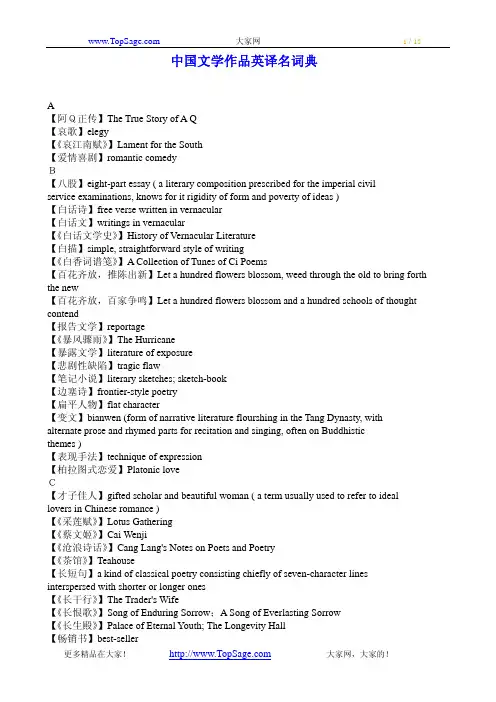

四大名著的英语翻译题六级翻译原文中国的四大名著(the Four Great Classical Novels)指创作于明清时期的四部最伟大、最有影响力的小说。
阅读四大名著,可以了解中国传统的社会、历史、地理、民俗和处世哲学。
大多数的中国人对这四部小说中的人物、情节和场景都很熟悉。
它们已经深深地影响了中国人的思想(mentality)、观念和价值观。
现在,四部小说都已被改编成电影或电视剧(TV series),受到很多观众的喜爱。
四大名著都具有很高的艺术水平,是中华民族的宝贵遗产,在中国文学史上也是一大创举。
六级参考翻译:The Four Great Classical Novels of China refer to thefour greatest and most influential novels written inthe Ming and Qing Dynasties. Reading them canacquaint people with traditional Chinese society,history, geography, folk customs and philosophy oflife. Most Chinese are pretty familiar with the figures, plots and scenes in the four novels. Theyhave profoundly influenced the mentality, ideas and values of Chinese people. Nowadays, thefour novels have already been adapted into movies or TV series, favored by lots of audiences.Being high in artistic standard, the Four Great Classical Novels are precious heritages ofChinese nation and pioneering works in the history of Chinese literature.英语四六级翻译中国特色词汇:四大名著《三国演义》 Three Kingdoms《西游记》 Journey to the West; Pilgrimage to the West《水浒传》 Heroes of the Marshes; Tales of the Water Margin《红楼梦》 Dream of the Red Mansions【三国演义翻译原文】《三国演义》写于14世纪,是中国著名的历史小说。
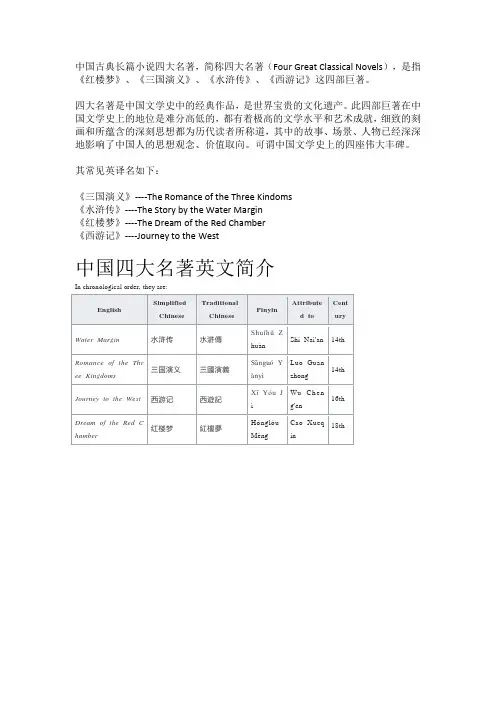
中国古典长篇小说四大名著,简称四大名著(Four Great Classical Novels),是指《红楼梦》、《三国演义》、《水浒传》、《西游记》这四部巨著。
四大名著是中国文学史中的经典作品,是世界宝贵的文化遗产。
此四部巨著在中国文学史上的地位是难分高低的,都有着极高的文学水平和艺术成就,细致的刻画和所蕴含的深刻思想都为历代读者所称道,其中的故事、场景、人物已经深深地影响了中国人的思想观念、价值取向。
可谓中国文学史上的四座伟大丰碑。
其常见英译名如下:《三国演义》----The Romance of the Three Kindoms《水浒传》----The Story by the Water Margin《红楼梦》----The Dream of the Red Chamber《西游记》----Journey to the West中国四大名著英文简介红楼梦 The Dream of the Red ChamberDream of the Red Chamber, also called The Story of the Stone, composed by Cao Xueqin, is one ofChina's Four Great Classical Novels. It was written sometime in the middle of the 18th century duringthe Qing Dynasty. Long considered a masterpiece of Chinese literature, the novel is generallyacknowledged to be the pinnacle of Chinese fiction. "Redology" is the field of study devoted exclusively tothis work.The title has also been translated as Red Chamber Dream and A Dream of Red Mansions. The novelcirculated in manuscript copies with various titles until its print publication, in 1791. Gao E, who preparedthe first and second printed editions with his partner Cheng Weiyuan in 1791–2, added 40 additionalchapters to complete the novel.Red Chamber is believed to be semi-autobiographical, mirroring the rise and decline of author CaoXueqin's own family and, by extension, of the Qing Dynasty. As the author details in the first chapter, it isintended to be a memorial to the damsels he knew in his youth: friends, relatives and servants. The novel isremarkable not only for its huge cast of characters and psychological scope, but also for its precise anddetailed observation of the life and social structures typical of 18th-century Chinese society.Also called "The story of the Stone (Shitouji 石头记)", this novel written by Cao Xueqin 曹雪芹(d. 1763) is said to be the greatest masterpiece of Chinese fiction. A wide branched scholarship does not consent about the main theme of this novel, should it be a novel of sentiment, of Daoist-Buddhist enlightenment, of social observation, of the decay of an aristocratic familiy, or even a veiled attack on Manchu rule. The frame of the novel is the contest of a Buddhist and a Daoist priest who make be born a young noble boy called Jia Baoyu 贾宝玉and his girl cousin Lin Daiyu 林黛玉.With a loving detail describing the life of the two cousins in a huge noble mansion, between gardens and palaces, the red thread is the triangular love between Baoyu, Daiyu and a second girl cousin called Xue Baochai 薛宝钗that is of more plumper character than the ever sick Daiyu. Switching between their life, the divine world and dreams, Baoyu becomes deranged after the disappearance of a stone (the origin of the second title) he had in his mouth when he was born. Not knowing, his love Daiyu died, he is tricked to marrying Baochai. Becoming aware of being tricked, Baoyu leaves the world of the "red dust" and becomes a monk. With hundreds of persons and their stories, paralleling the life and feelings of servants to the life of the main persons, the story is very complex and full of symbolisms, but very interesting and convincing for its encyclopedic character, depicting the life of a noble familiy in the 18th century Q ing China.三国演义Romance of The Three KingdomsRomance of the Three Kingdoms is a 14th-century historical novel attributed to Luo Guanzhong. It is setin the turbulent years towards the end of the Han dynasty and the Three Kingdoms period in Chinesehistory, starting in 169 AD and ending with the reunification of the land in 280.The story – part historical, part legend, and part mythical – romanticises and dramatises the lives of feudallords and their retainers, who tried to replace the dwindling Han dynasty or restore it. While the novelfollows hundreds of characters, the focus is mainly on the three power blocs that emerged from theremnants of the Han dynasty, and would eventually form the three states of Cao Wei, Shu Han, and EasternWu. The novel deals with the plots, personal and military battles, intrigues, and struggles of these states toachieve dominance for almost 100 years.Romance of the Three Kingdoms is acclaimed as one of the Four Great Classical Novels of Chineseliterature; it has a total of 800,000 words and nearly a thousand dramatic characters (mostly historical) in120 chapters. The novel is among the most beloved works of literature in East Asia, and its literaryinfluence in the region has been compared to that of the works of Shakespeare on English literature. It isarguably the most widely read historical novel in late imperial and modern China.Romance of The Three Kingdoms is one of the great chinese classics and is compiled into a semi-fictional literary masterpiece during the Ming Dynasty by Luo Guanzhong. The novel comprises around 70+% fact and 20+% fiction. Some issues such as Guan Yu's weapon weighing around 40+ kilograms, the capabilties of Lu Bu, Liu Bei's horses as well as the existence of the Hill of the Fallen Phoenix and some others are probably fictional.That period in history can be said as the golden age of chivalry and although it happened more than 1700 years ago, characters such as Liu Bei, Cao Cao, Guan Yu, Zhang Fei and Zhuge Liang have become household names among the chinese. Tales of their exploits, courage, adventures and many more are told in the novel "Romance of The Three Kingdoms".It is one of the most turbulent periods in China's history taking place toward the end of the Han Dynast y where corruption is rampant in the imperial court due to eunuches holding power. Coupled with natural disasters such as floods, plague and locust swarms devouring the crops grown by the peasants, hunger and disatisfaction among the peasants soon escalated rapidly until a major rebellion known as the "Yellow Scarves Rebellion" led by Zhang Jiao broke out. (It was dubbed "Yellow Scarves" because the rebels tied a yellow scarf on their head). Initially just a small band of rebels, dueto widespread hunger and ill-sentiment among the populace, swarms of common folks joined in the rebellion across many parts of the country.三国演义人物介绍刘备Liu Bei (161–223 AD), styled Xuándé (玄徳), was a general, warlord, and later the founding emperor of Shu Han during the Three Kingdoms era of China. Although having a later start than his rivals, also lacking both the material resources and social status they commanded, Liu Bei overcame his many defeats to carve out his own realm, that at its peak spanned modern day Sichuan, Guizhou, Hunan, part of Hubei, and part of Gansu.Culturally, due to the tremendously popular novel Romance of the Three Kingdoms by Luo Guanzhong, Liu Bei is widely known as the ideal benevolent, humane ruler who cared for his people and picked good advisors. His character was to advocate the Confucian set of moral values, such as loyalty and compassion.张飞Zhang Fei (?-221 AD) was a military general of Shu Han during the Three Kingdoms era of China.Zhang Fei was shown to have been a masterful general rather than simply a warrior. He treated hissuperiors with respect, but had little respect for his underlings. He was often warned by Liu Bei that hishabit of over-punishing his own soldiers by lashing and killing would eventually bring himself disaster.Zhang Fei married Xiahou Yuan's daughter, who was captured by Zhang Fei's troops as she was outgathering firewood. They had a total of two daughters, and the older daughter became the empressof Shu Han after marrying Liu Shan, with Zhuge Liang as the matchmaker. After Zhang Fei's eldestdaughter had passed away due to natural causes, Zhuge Liang once again played the role ofmatchmaker, and Liu Shan married Zhang Fei's younger daughter, who thus succeeded her oldersister to become the empress of Shu Han.Zhang Fei is best portrayed through his description and actions depicted in Records of Three Kingdomsbiography by Chen Shou. Some claim that Zhang Fei was also an excellent painter.Zhang Fei was killed by his own men Zhang Da and Fan Jiang, while preparing his troops to attack therival Eastern Wu to avenge the death of Guan Yu. Zhang Da and Fan Jiang went on to defect to Wu.水浒传Outlaws of the Marsh / Water MarginWater Margin is a Chinese novel attributed to Shi Nai'an. Considered one of the Four Great ClassicalNovels ofChinese literature, the novel is written in vernacular Chinese rather than Classical Chinese.The story, set in the Song dynasty, tells of how a group of 108 outlaws gather at Mount Liang (orLiangshan Marsh) to form a sizable army before they are eventually granted amnesty by the governmentand sent on campaigns to resist foreign invaders and suppress rebel forces. It has introduced to readersmany of the best-known characters in Chinese literature, such as Wu Song, Lin Chong and Lu Zhishen.The novel "Outlaws of the Marsh" is somewhat like the Iliad and Odyssey... An ancient epic tale... no one remembers the period it was composed and immortalized.One knows this story is based on real facts and has inspired many storytellers.One knows the North Song Dynasty (XIIIth Century) lived its apogee and declined, a victim of corruption and decadence.One finds historical traces of these outlaws who challenged the imperial authority and died under the executioner's blade.At last, as anyone knows today that a man called Homer wrote the Iliad and Odyssey, no one doubts anymore that a man called Shi Nai-an wrote down during the XIVth century the novel Outlaws of the Marsh that reached us.Everyone recognizes that Jin Sheng-tan, during the XVIIth century, published what is now famous as the original version of a novel that obtained the interest and infatuation of successive generations.Water Margin or Outlaws of the Marsh ("All men are brothers" in Pearl Buck's translation, "Shui hu zhuan" in Chinese, "Au Bord de l'Eau" in French ) is an immortal novel because its tale is universal : it speaks of beings (outlaws but also notables, strong muscled heroes but also intellectual, anarchists but also philosophers...) who cannot bear injustice nor abuse nor arbitrariness...That is the reason they are immortal and their popularity has lasted for centuries .Discover the 108 heroes, the episodes , the paper-cuts representing them, the Beijing operas their fighting exploits inspired...人物Gai Ping Health gave special love make the world anyway, famous arena. Like charges to stick, chicken, and did not take wives, all hit others physique. Village Creek Village haunted legends, villagers digging a river in the town engraved art, ghost was rushed to the East seven. Classical hell, then alone will be engraved Creek Village in places away from the East side down. Thus so-called "Tota kings".晁盖平生仗义疏财,专爱结交天下好汉,闻名江湖。
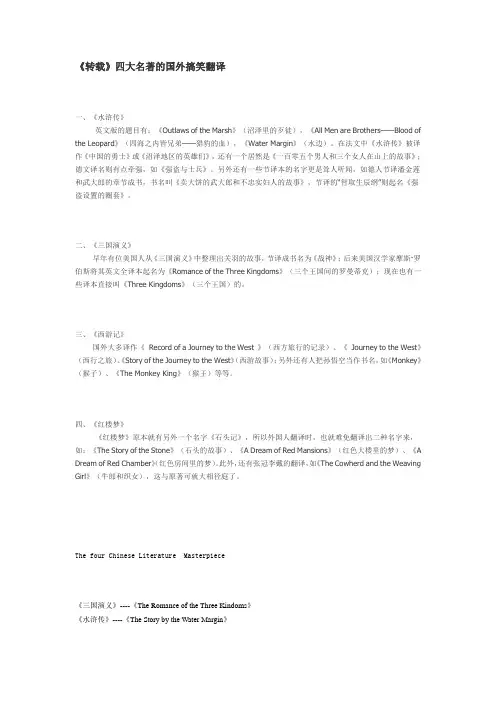
《转载》四大名著的国外搞笑翻译一、《水浒传》英文版的题目有:《Outlaws of the Marsh》(沼泽里的歹徒),《All Men are Brothers——Blood of the Leopard》(四海之内皆兄弟——猎豹的血),《Water Margin》(水边)。
在法文中《水浒传》被译作《中国的勇士》或《沼泽地区的英雄们》,还有一个居然是《一百零五个男人和三个女人在山上的故事》;德文译名则有点牵强,如《强盗与士兵》。
另外还有一些节译本的名字更是耸人听闻,如德人节译潘金莲和武大郎的章节成书,书名叫《卖大饼的武大郎和不忠实妇人的故事》,节译的“智取生辰纲”则起名《强盗设置的圈套》。
二、《三国演义》早年有位美国人从《三国演义》中整理出关羽的故事,节译成书名为《战神》;后来美国汉学家摩斯·罗伯斯将其英文全译本起名为《Romance of the Three Kingdoms》(三个王国间的罗曼蒂克);现在也有一些译本直接叫《Three Kingdoms》(三个王国)的。
三、《西游记》国外大多译作《Record of a Journey to the West 》(西方旅行的记录)、《Journey to the West》(西行之旅)、《Story of the Journey to the West》(西游故事);另外还有人把孙悟空当作书名,如《Monkey》(猴子)、《The Monkey King》(猴王)等等。
四、《红楼梦》《红楼梦》原本就有另外一个名字《石头记》,所以外国人翻译时,也就难免翻译出二种名字来,如:《The Story of the Stone》(石头的故事)、《A Dream of Red Mansions》(红色大楼里的梦)、《A Dream of Red Chamber》(红色房间里的梦)。
此外,还有张冠李戴的翻译,如《The Cowherd and the Weaving Girl》(牛郎和织女),这与原著可就大相径庭了。
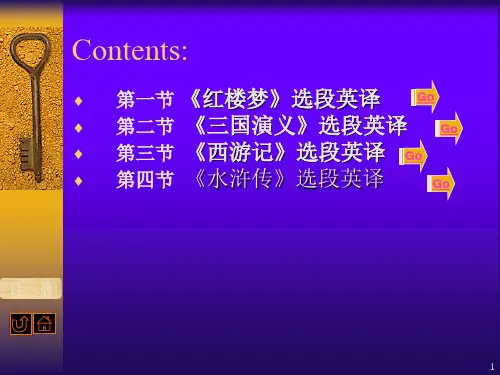
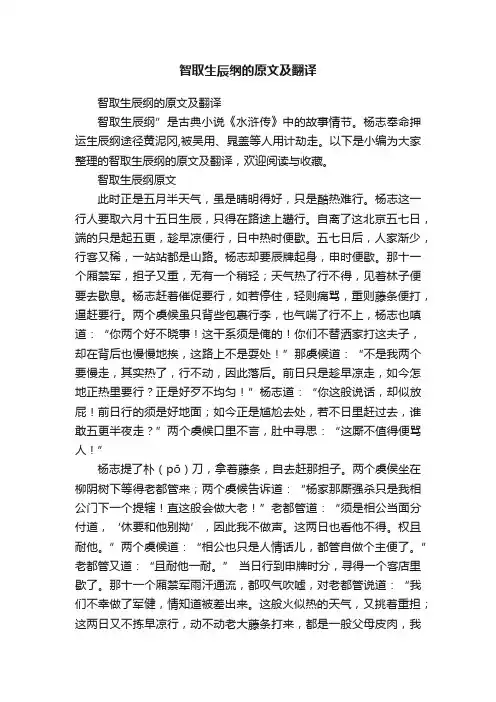
智取生辰纲的原文及翻译智取生辰纲的原文及翻译智取生辰纲”是古典小说《水浒传》中的故事情节。
杨志奉命押运生辰纲途径黄泥冈,被吴用、晁盖等人用计劫走。
以下是小编为大家整理的智取生辰纲的原文及翻译,欢迎阅读与收藏。
智取生辰纲原文此时正是五月半天气,虽是晴明得好,只是酷热难行。
杨志这一行人要取六月十五日生辰,只得在路途上趱行。
自离了这北京五七日,端的只是起五更,趁早凉便行,日中热时便歇。
五七日后,人家渐少,行客又稀,一站站都是山路。
杨志却要辰牌起身,申时便歇。
那十一个厢禁军,担子又重,无有一个稍轻;天气热了行不得,见着林子便要去歇息。
杨志赶着催促要行,如若停住,轻则痛骂,重则藤条便打,逼赶要行。
两个虞候虽只背些包裹行李,也气喘了行不上,杨志也嗔道:“你两个好不晓事!这干系须是俺的!你们不替洒家打这夫子,却在背后也慢慢地挨,这路上不是耍处!”那虞候道:“不是我两个要慢走,其实热了,行不动,因此落后。
前日只是趁早凉走,如今怎地正热里要行?正是好歹不均匀!”杨志道:“你这般说话,却似放屁!前日行的须是好地面;如今正是尴尬去处,若不日里赶过去,谁敢五更半夜走?”两个虞候口里不言,肚中寻思:“这厮不值得便骂人!”杨志提了朴(pō)刀,拿着藤条,自去赶那担子。
两个虞侯坐在柳阴树下等得老都管来;两个虞候告诉道:“杨家那厮强杀只是我相公门下一个提辖!直这般会做大老!”老都管道:“须是相公当面分付道,‘休要和他别拗’,因此我不做声。
这两日也看他不得。
权且耐他。
”两个虞候道:“相公也只是人情话儿,都管自做个主便了。
”老都管又道:“且耐他一耐。
” 当日行到申牌时分,寻得一个客店里歇了。
那十一个厢禁军雨汗通流,都叹气吹嘘,对老都管说道:“我们不幸做了军健,情知道被差出来。
这般火似热的天气,又挑着重担;这两日又不拣早凉行,动不动老大藤条打来,都是一般父母皮肉,我们直恁(nèn)地苦!”老都管道:“你们不要怨怅,巴到东京时,我自赏你。
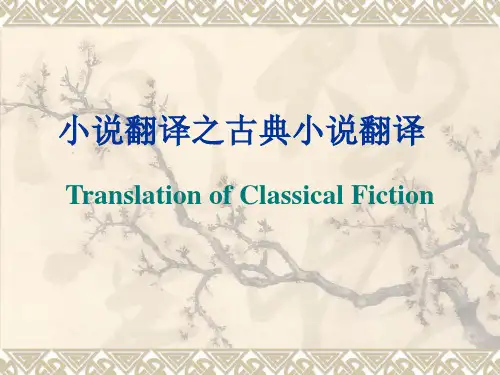
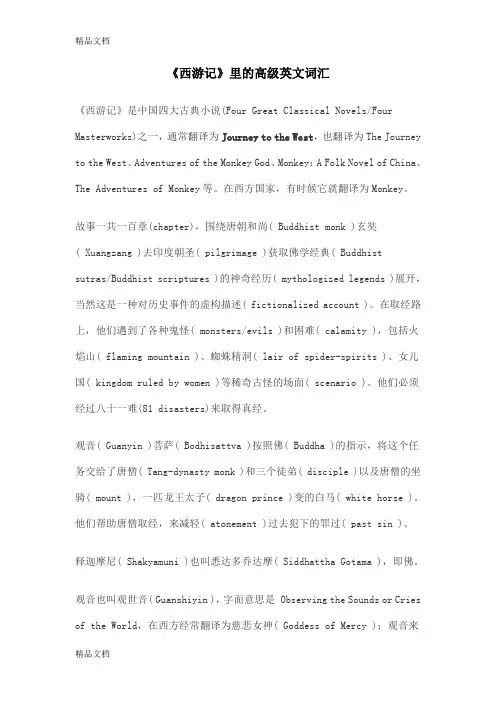
《西游记》里的高级英文词汇《西游记》是中国四大古典小说(Four Great Classical Novels/Four Masterworks)之一,通常翻译为Journey to the West,也翻译为The Journey to the West、Adventures of the Monkey God、Monkey:A Folk Novel of China、The Adventures of Monkey等。
在西方国家,有时候它就翻译为Monkey。
故事一共一百章(chapter),围绕唐朝和尚( Buddhist monk )玄奘( Xuangzang )去印度朝圣( pilgrimage )获取佛学经典( Buddhistsutras/Buddhist scriptures )的神奇经历( mythologized legends )展开,当然这是一种对历史事件的虚构描述( fictionalized account )。
在取经路上,他们遇到了各种鬼怪( monsters/evils )和困难( calamity ),包括火焰山( flaming mountain )、蜘蛛精洞( lair of spider-spirits )、女儿国( kingdom ruled by women )等稀奇古怪的场面( scenario )。
他们必须经过八十一难(81 disasters)来取得真经。
观音( Guanyin )菩萨( Bodhisattva )按照佛( Buddha )的指示,将这个任务交给了唐僧( Tang-dynasty monk )和三个徒弟( disciple )以及唐僧的坐骑( mount ),一匹龙王太子( dragon prince )变的白马( white horse )。
他们帮助唐僧取经,来减轻( atonement )过去犯下的罪过( past sin )。

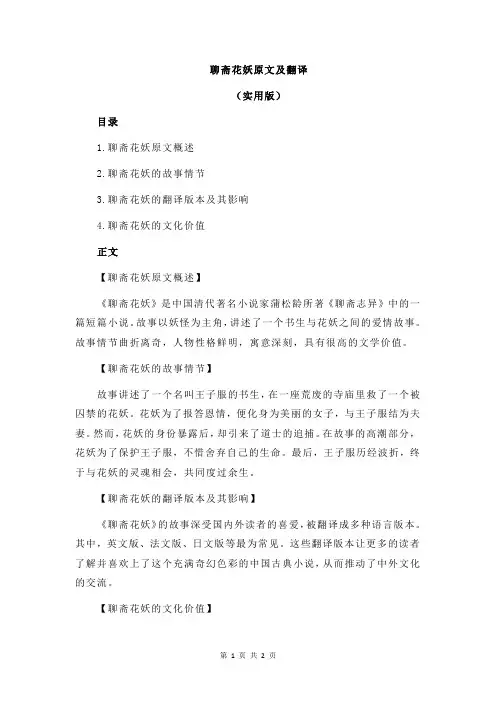
聊斋花妖原文及翻译
(实用版)
目录
1.聊斋花妖原文概述
2.聊斋花妖的故事情节
3.聊斋花妖的翻译版本及其影响
4.聊斋花妖的文化价值
正文
【聊斋花妖原文概述】
《聊斋花妖》是中国清代著名小说家蒲松龄所著《聊斋志异》中的一篇短篇小说。
故事以妖怪为主角,讲述了一个书生与花妖之间的爱情故事。
故事情节曲折离奇,人物性格鲜明,寓意深刻,具有很高的文学价值。
【聊斋花妖的故事情节】
故事讲述了一个名叫王子服的书生,在一座荒废的寺庙里救了一个被囚禁的花妖。
花妖为了报答恩情,便化身为美丽的女子,与王子服结为夫妻。
然而,花妖的身份暴露后,却引来了道士的追捕。
在故事的高潮部分,花妖为了保护王子服,不惜舍弃自己的生命。
最后,王子服历经波折,终于与花妖的灵魂相会,共同度过余生。
【聊斋花妖的翻译版本及其影响】
《聊斋花妖》的故事深受国内外读者的喜爱,被翻译成多种语言版本。
其中,英文版、法文版、日文版等最为常见。
这些翻译版本让更多的读者了解并喜欢上了这个充满奇幻色彩的中国古典小说,从而推动了中外文化的交流。
【聊斋花妖的文化价值】
《聊斋花妖》在文学史上具有重要地位,其文化价值主要体现在以下几个方面:首先,它是中国古代小说中典型的以妖怪为主角的作品,展现了古代人们对神秘世界的想象;其次,作品通过讲述王子服与花妖的爱情故事,表现了忠诚、善良、勇敢等美好品质;最后,故事中花妖的形象具有很强的艺术感染力,成为了中国古典文学中一个令人难忘的经典形象。
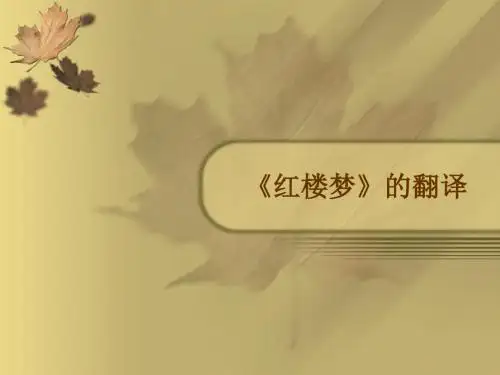
《凤凰杂志》与中国古典小说的翻译《凤凰杂志》是19世纪一种关于中国及东亚重要的英文杂志,以介绍中国及日本、印度、缅甸、暹罗等东亚国家的文学、历史、地理、宗教等为主要内容,是一份强调直接性、学术性及资料性的综合性杂志。
对中国古典小说的翻译和介绍是《凤凰杂志》的重要部分,它既为其读者提供了中国古典文学的直接样本,也作为西方了解中国人习俗和生活的重要参考,促进了中国古典小说在西方的译介,扩展了西方对中国及其文学的认识。
译文则为:“When I came to Soo-chow,”was her answ er,“I found it among my husband’s clothes?鸦where he obtained it I cannot say.”(我到苏州之时,在丈夫的衣物中见了这珍珠衫,他从何处得来,我并不晓得。
)译文和中文中平氏发现珍珠衫的时机亦从陈大郎回到新安之时改为平氏到苏为夫安葬之后。
另外,译文亦对中文故事情节重新进行了编排,将兴哥平氏完婚的情节置于兴哥陷讼、三巧儿营救、夫妻再聚的情节之后。
从而模糊了三巧儿从妻转而为妾的身份变化,而中文中三巧儿身份的变化正是小说中宣扬的对女子行为不贞的惩罚,旨在规劝人们不可耽与情色。
《杜十娘怒沉百宝箱》的译文中比较突出的是对中文小说中的诗词做出了翻译,且译文比较准确优美,较好地把握和传达了小说中诗词的主旨和意境,在一定程度上保证了小说译文的完整性。
如:扫荡残胡立帝畿(Clearing away the plundering foreigners,he established the Im-perial district),龙翔凤舞势崔嵬(The flight of the drag-on,the sport of the phoenix,prevailed in the rocky hills);左环沧海天一带(On the right,sur-rounded by the Eastern sea,and the heaven as girdle)?鸦右庸太行山万围(On the left,embracing the innumerable barriers of the Tae-hing hills)。
马树全译注的八本古典书-概述说明以及解释1.引言1.1 概述概述部分:随着全球化进程的不断加深,汉语文化的传播和交流已经成为当今世界的热点话题。
而古典书的翻译和注释是汉语文化传播的重要方式之一。
在这个领域,马树全先生是一位杰出的翻译家和注释家,他以其深厚的学术造诣和精湛的翻译技巧,在汉语经典著作的翻译和注释领域树立了卓越的地位。
本文将重点介绍马树全先生所翻译和注释的八本古典书,这些书籍包括了中国古代文学的重要作品,涵盖了文学、哲学、历史等多个领域。
马树全先生在对这些书籍进行翻译和注释时,不仅充分保留了原作的风采和内涵,还注入了自己的学术见解和理解,使这些古典著作更加贴近读者、易于理解。
通过对马树全先生翻译和注释的八本古典书的整理和分析,我们可以深入了解中国古代文化和思想的精髓,感受到独特的东方智慧。
这些古典著作涵盖了社会伦理、哲学思考、人生态度等多个方面的内容,对读者的启示和影响是深远的。
通过阅读这些经典著作的马树全译注版,读者不仅可以领略到中国古代文化的瑰宝,还可以获得自身思考和成长的动力。
综上所述,本文将通过对马树全先生翻译和注释的八本古典书的介绍和分析,探讨马树全译注对古典书的意义以及对读者的启示和影响。
通过此次的研究,我们可以更加深入地了解马树全先生的学术贡献,也可以进一步提高自身对中国古典文化的理解和认知水平。
1.2文章结构1.2 文章结构本篇长文分为引言、正文和结论三个部分。
下面对每个部分的内容进行详细介绍:1. 引言引言部分主要包括概述、文章结构和目的三个小节。
在概述中,我们将简要介绍本篇长文的主题、马树全译注的背景以及八本古典书的重要性。
在文章结构部分,我们将详细说明本篇长文的组织结构,帮助读者了解文章的内容安排。
目的部分将明确本篇长文的写作目标和意义,以使读者更好地理解文章的出发点和写作动机。
2. 正文正文部分分为两个小节:马树全的背景介绍和八本古典书的简介。
首先,在马树全的背景介绍中,我们将详细介绍马树全先生的生平事迹、学术贡献以及他对古典书的研究和翻译工作。
桃花笑,姓杨,字笑之,乃江南苏州人士。
其父杨守正,为官清廉,家道中落。
笑之自幼聪颖,喜好文学,尤擅诗词。
因其貌不扬,故常被人轻视。
笑之虽处境艰难,却矢志不渝,终成一代才子。
一日,笑之出游至苏州城外,偶遇一美女子,名为苏蓉蓉。
蓉蓉乃富家千金,才貌双全,却因家族破产,被迫嫁给一粗鲁武夫。
笑之与蓉蓉一见钟情,两人私定终身。
然而,笑之家境贫寒,蓉蓉之父坚决反对,欲将女儿嫁给一权贵。
笑之得知此事后,心生一计。
他假装被权贵收买,答应为权贵撰写一篇歌颂其功德的文章。
权贵大喜,遂将笑之招至府中。
笑之趁机向权贵揭露其罪行,并劝说其悔过自新。
权贵深受感动,遂答应放弃与蓉蓉的婚约。
然而,蓉蓉之父却因女儿背叛而怀恨在心,派人追杀笑之。
笑之逃至一荒山野岭,偶遇一仙姑。
仙姑见笑之才华横溢,心生爱慕,遂传授他一门神奇的武功。
笑之习得武功后,终于打败追杀者,回到苏州。
此时,蓉蓉之父已经悔过自新,并承认错误。
笑之与蓉蓉得以团聚,共度美好时光。
然而,好景不长,笑之得知权贵再次作恶,便决定离开苏州,远赴他乡,为民除害。
在笑之离开苏州的途中,他结识了众多志同道合的朋友,共同对抗邪恶势力。
在一场激战中,笑之不幸受伤,险些丧命。
蓉蓉得知此事后,毅然决定追随笑之,共同面对困境。
经过一番艰苦努力,笑之与蓉蓉终于打败了权贵,为民除害。
然而,在这场斗争中,笑之与蓉蓉都付出了巨大的代价。
笑之失去了双亲,蓉蓉则失去了双腿。
尽管如此,两人仍然不离不弃,携手共度余生。
桃花笑一书,以其丰富的想象力和独特的叙事手法,描绘了一幅生动的社会生活画卷。
笑之与蓉蓉的爱情故事,更是让人感动不已。
该书以桃花笑为中心,展现了当时社会的风俗民情,反映了人性的善恶美丑。
在我国古典小说中,具有很高的艺术价值。
以下是《桃花笑》一书的简要翻译:桃花笑,姓杨,字笑之,江南苏州人也。
父杨守正,官清廉,家道中落。
笑之自幼聪颖,喜好文学,尤擅诗词。
貌不扬,常被人轻视。
笑之虽处境艰难,却矢志不渝,终成一代才子。
红楼梦第二回翻译成现代文的(原创版)目录1.红楼梦第二回的现代文翻译2.贾宝玉的出生及家庭背景3.贾宝玉的性格特点4.贾宝玉与林黛玉的关系5.贾宝玉与薛宝钗的关系正文《红楼梦》是我国古典小说四大名著之一,作者是曹雪芹。
本文将通过现代文的方式,解析《红楼梦》第二回的内容。
在这一回中,主要讲述了贾宝玉的出生及家庭背景、性格特点以及他与林黛玉、薛宝钗的关系。
贾宝玉,是故事的主要人物之一。
他出生在一个权贵家庭,父亲贾政在朝为官,地位显赫。
母亲贾母则是家中的掌权人,十分溺爱贾宝玉。
贾宝玉还有一个姐姐贾元春,已经嫁给了皇帝,成为贵妃。
此外,贾宝玉还有一个表妹林黛玉和表姐薛宝钗,她们与他的关系错综复杂,成为了故事的重要线索。
贾宝玉的性格特点非常鲜明。
他自幼生活在富贵之家,却对世俗礼教不屑一顾,喜欢与女子为伍,尤其与林黛玉关系密切。
贾宝玉有着敏锐的观察力和同情心,对家中的奴仆们态度和蔼可亲,反感家族中的欺压与虐待。
同时,他厌恶四书五经,对传统的学习方式并不感兴趣,却喜欢诗词歌赋等文艺作品。
贾宝玉与林黛玉的关系非常特殊。
两人自幼生活在一起,感情深厚。
林黛玉聪明伶俐,才情出众,贾宝玉十分喜欢她。
然而,林黛玉身世凄苦,母亲早逝,父亲林如海也去世后,她便寄人篱下,与贾宝玉一家共同生活。
虽然贾母也十分疼爱林黛玉,但她的身世终究无法与薛宝钗相比。
贾宝玉与薛宝钗的关系则充满了政治因素。
薛宝钗出身名门,母亲是贾母的妹妹,父亲虽然已经去世,但家族势力仍在。
在贾母的安排下,贾宝玉与薛宝钗成婚。
虽然贾宝玉对这段婚姻并不感兴趣,但他无法抗拒家族的压力,只能顺从。
通过以上分析,《红楼梦》第二回向我们展示了贾宝玉的出生及家庭背景、性格特点以及他与林黛玉、薛宝钗的关系。
这些关系错综复杂,为后面的故事发展埋下了伏笔。
痴婆子传原文翻译
痴婆子传原文翻译:郑卫的家乡有一个老妇人,年岁已经有七十岁,头发花白牙齿脱落,寄居在狭窄小巷。
喜欢谈论往事层叠不厌倦,也是往来里的公卿大臣家里。
燕国有炸客就又问,她老了,然而自由态飘扬,丰满韵味潇洒。
如果不是弯着腰手持棍棒的人,就在年不衰时,不也是一个好朋友吗。
恨我生晚,不能获得全部老太太的行为收藏,然而当看到老太太的丰标在今天的。
老太太请试着说的,我愿意倾听他。
原文如下:
原文: 郑卫之故墟有老妇焉。
年已七十,发白齿落,寄居隘巷。
喜谈往事叠叠不倦,亦往来里之公卿家里。
有燕筇客就而问之曰,媪老矣,然逸态飘动,丰韵潇洒,非若伛偻而持杖者, 则当年未艾时,不亦一佳人乎。
恨余生晚,不获悉媪之行藏, 然犹及见媪之丰标于今日也。
媪请试言之,某愿倾听焉。
媪笑曰,微子之言,亦将以告子。
今辱命之敢不布甚区区。
筇客曰,愿载杀青以从媪。
痴婆子相关内容
小说采用第一人称倒叙法,由70岁白发脱齿,但却风韵犹存的老妪上官阿娜,叙说一生经历的风流韵事。
阿娜出生在一个严守儒教的家庭,自幼受到性压抑。
因七八岁时吟咏不从雪后争娇态,还向月中含丽情诗句。
书中以痴婆子自身的叙述为中心,展开故事情节,通过她对往事的回忆,牵连出了她扶少女时代、婚后直到被丈夫休回娘家的一生遭遇。
小说的叙事艺术蕴含了一种独特的小说观念,作品把女性视角的自我讲述、第一人称内聚焦限制叙事、倒装叙事与讽刺修辞等多种叙事手法结合在一起,在中国古典小说中是一种独创。
东篱记翻译
《东篱记》,又名宁芸,是一部十六世纪著名的中国古典小说。
该小说讲述了
父亲留给他一条耗尽所有财产但尚能立足的东楼,以及在东楼里暗暗期望融入社会上流利莎士比亚的宁芸之故事。
宁芸从她贫苦农家背景起步,懂得以重财宝贵择友,及其他技巧,终于在生态和边陲社会中找到自己的居所,实现了自己的理想,最终成为当地的一个上等人物。
这部小说中穿插的东方情节和英式文化充满变化,文意深邃,宁芸也是一个精
致的角色,充满了转换的境遇,小说让人印象深刻。
除了小说的文字细致描写的情节,原著中多处的暗示和隐喻,也让我们重新认识宁芸这个人物,并从文本中受到训练学习,我们可以从中反省人生,把握今天。
此外,许多作者也把“东篱记”作为一个作品,用它来展示他们的想法,如“芸”的情节在许多电视剧中被重复上演,“东篱记”的旋律也在现代流行音乐中被不断使用,也深受观众家的喜爱。
通过“东篱记”这部小说,让我们身临其境地体会各种心境变化和情感波动,
了解精髓东方文化,品味中国传统文学,以满腔热情投入宁芸的生活,来感受不一样的生活娱乐。